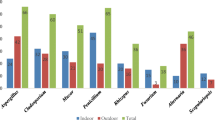Abstract
Black yeast (MM-7) isolated from a humidifier was studied morphologically, biologically and serologically. Furthermore, its pathogenicity was compared with that of four human isolates of Exophiala dermatitidis.
The MM-7 is dimorphic and its growth at 37 °C was better than that at 27 °C. Giant colonies of the MM-7 were very similar to those of the four human isolates. Microscopically, hyphae were pale brown, slender or toruloid. Cylindrical, bottle- or flaskshaped conidiogenous cells arose from the tips and sides of the hyphae. Conidiogenous foci were also seen as small projections at the lateral walls of hyphae. One to four projections were seen at the conidiogenous apices by scanning electron microscopy. Annellation could be observed clearly on them. It was also seen in all of the human isolates of E. dermatitidis used for reference. Conidia were globose to subglobose, one celled, smooth, hyaline to brown.
The MM-7 utilized all carbon compounds examined except lactose, melibiose and raffinose. It split arbutin, but did not hydrolyze starch. It utilized neither potassium nitrate, nor hydrolyzed skim milk and gelatin.
The GC content of the MM-7 (56.6%) was almost the same as that of Kano's isolate (58%) and titers of agglutinin of the anti-E. dermatitidis serum to the MM-7 and four isolates of the fungus were 512-fold.
From these morphological, biological and serological examinations the MM-7 was identified as E. dermatitidis (Kano) de Hoog.
As far as pathogenicity is concerned, the MM-7 showed the strongest pathogenicity of all. Two of the ten mice inoculated intravenously with 5×106 cells of the MM-7 died on the 6th and 7th day, and the fungus was recovered from various organs. Histopathologically, the brains were affected severely. A large number of polymorphonuclear leucocytes accumulated around short hyphae and yeast cells to form micro-abscesses. Some micro-granulomatous lesions with a few yeast cells were also observed. Seven of the surviving eight mice showed nervous symptoms. The MM-7 was recovered from the brains of the four mice sacrificed on the 30th day. Some granulomatous lesions with a few yeast cells were recognized in the tissues.
Similar content being viewed by others
References
Cole, G. T., 1978. Conidiogenesis in the black yeasts. The Black and White Yeasts, Pan American Health Organization, Washington, D.C., p. 66–78.
Conti-Díaz, I. A., Mackinnon, J. E. & Civilia, E., 1978. Isolation and identification of black yeasts from the external environment in Urguay. The black and White Yeasts, Pan American Health Organization, Washington, D.C., p. 109–114.
De Hoog, G. S., 1977. Studies in Mycology. No. 15 Rhinocladiella and allied genera, p. 118–119.
Dixon, D. M. & Shadomy, H. J., 1980. Taxonomy and morphology of dematiaceous fungi isolated from nature. Mycopathologia 70: 139–144.
Dixon, D. M., Shadomy, H. J. & Shadomy, S., 1980. Dematiaceous fungal pathogens isolated from nature. Mycopathologia 70: 153–161.
Emmons, C. W., 1966. Pathogenic dematiaceous fungi. Japan. J. Med. Mycol. 7: 233–245.
Frank, W. & Roester, U., 1970. Amphibien als Träger von Hormiscium (Hormodendrum) dermatitidis KANO, 1937, einem Erreger der Chromoblastomykose (Chromomykose) des Menschen. Zeitschrift für Tropenmedizin und Parasitologie 21: 93–108.
Fukushiro, R., 1977. Some considerations on infections by dematiaceous fungi, with special regard to chromomycosis. Japan. J. Med. Mycol. 18: 398–421.
Gordon, M. A. & Al-Doory, Y., 1965. Application of fluorescent-antibody procedures to the study of pathogenic dematiaceous fungi. II Serological relationships of the genus Fonsecaea. J. Bacteriol. 89: 551–556.
Grippo, P., Iaccarino, M., Rossi, M. & Scarano, E., 1965. Thinlayer chromatography of nucleotides, nucleosides & nucleic acid bases. Biochem. Biophys. Acta 95: 1–7.
Hershey, A. D., Dixon, J. & Chase, M., 1953. Nucleic acid economy in bacteria infected with bactrio-phage T2. I. Purine and pyrimidine composition. J. General Physiol. 36: 777–789.
Jotisankasa, V., Nielsen Jr., H. S. & Conant, N. F., 1970. Phialophora dermatitidis: Its morphology and biology. Sabouraudia 8: 98–107.
Kano, K., 1937. Über die Chromoblastomykose durch einen noch nicht als pathogen beschriebenen Pilz: Hormiscium dermatitidis n. sp. Arch. Dermatol. Syph. 176: 282–294.
Kinka, S., Yamashita, K., Mizogami, I., Murakami, T. & Inoue, H., 1963. A case of chromoblastomycosis, with primary lesion on the pharynx, metastasized to the lungs and ear. Japan. J. Med. Mycol. 4: 71–80.
Lodder, J., 1970. The yeasts. 2nd ed. North-Holland Publishing Co.
Marmur, J., 1961. A procedure for the isolation of deoxyribonucleic acid from micro-organisms. J. Mol. Biol. 3: 208–218.
McGinnis, M. R., 1977. Wangiella, a new genus to accommodate Hormiscium dermatitidis. Mycotaxon 5: 353–363.
McGinnis, M. R., 1977. Wangiella dermatitidis, a correction. Mycotaxon 6: 367–369.
Mok, W. Y. & Luizâo, R. C. C., 1981. Serological analysis and pathogenic potentials of Wangiella dermatitidis isolated from bats. Mycopathologia 73: 93–99.
Nielsen, Jr. H. S.& Conant, N. F., 1967. Practical evaluation of antigenic relationships of yeast-like dematiaceous fungi. Sabouraudia 5: 283–294.
Nishimura, K., Miyaji, M. & Kawai, R., 1980. ‘Phialophora’ dermatitidis isolated from a humidifier. Japan. J. Med. Mycol. 21: 30.
Reiss, N. R. & Mok, W. Y., 1979. Wangiella dermatitidis isolated from bats in Manaus, Brazil. Sabouraudia 17: 213–218.
Shimazono, Y., Isaki, K., Torii, H., Otsuka, R. & Fukushiro, R., 1963. Brain abscess due to Hormodendrum dermatitidis (Kano) Conant, 1953. Report of a case and review of the literature. — Folia Psychiatrica et Neurologica Japonica 17: 80–96.
Tsai, C. Y., Lü, Y. C., Wang, L. T., Hsu, T. L. & Sung, J. L., 1966. Systemic chromoblastomycosis due to Hormodendrum dermatitidis (Kano) Conant. Amer. J. Clinical Pathol. 46: 103–114.
Watanabe, S., Hayakawa, M. & Nabekura, K., 1964. Chromoblastomycosis. Japan. J. Dermatol. 74: 665.
Watanabe, S., Hisakawa, M. & Aoshima, T., 1976. A case of chromomycosis. Japan. J. Med. Mycol. 16: 231.
Author information
Authors and Affiliations
Rights and permissions
About this article
Cite this article
Nishimura, K., Miyaji, M. Studies on a saprophyte of Exophiala dermatitidis isolated from a humidifier. Mycopathologia 77, 173–181 (1982). https://doi.org/10.1007/BF00518803
Issue Date:
DOI: https://doi.org/10.1007/BF00518803




